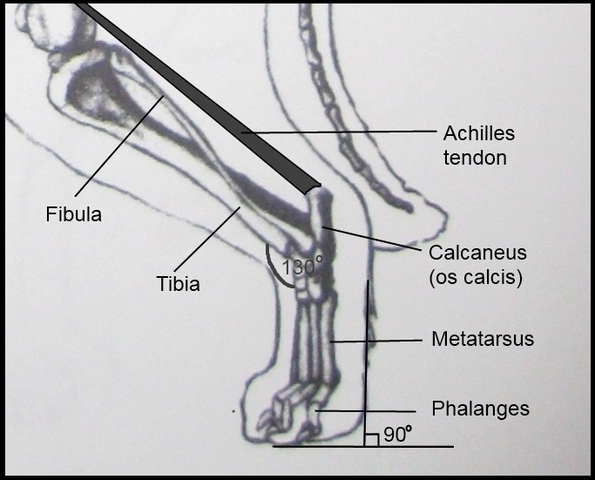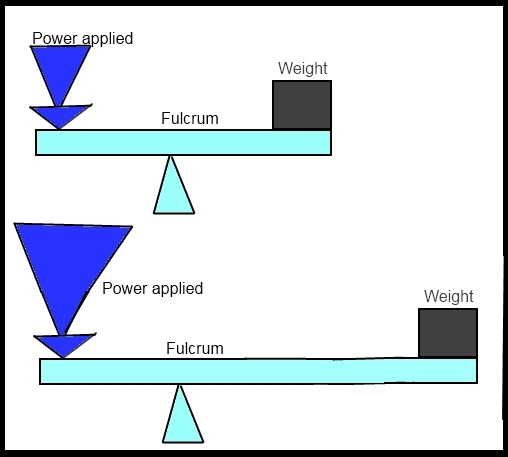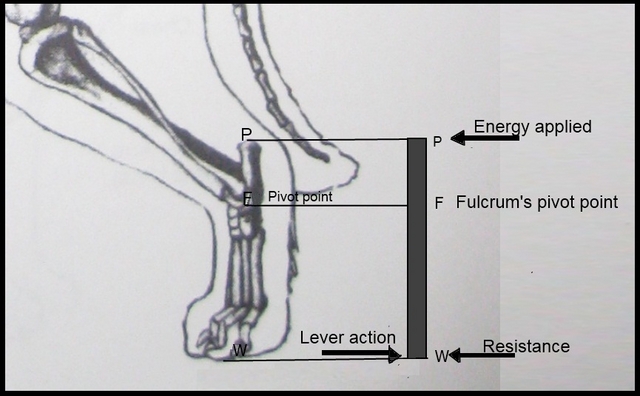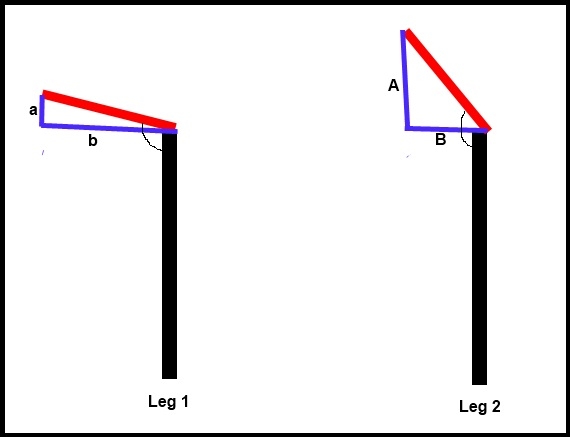Watercubs & Kivisilmän
working show-quality newfoundlands
and history
Mechanism of the hock in Newfoundlands
The Newfoundland breed standard asks for hocks ”well let down”, which comes from the horse term ”hocks and knees well let down”, meaning hocks and knees should be close to the ground. The standard is asking for a short set of bones between the hock joint and the ground, and a long set of bones between stifle (=knee joint) and hock.
The importance of the hock is often overlooked, but it has a very important and unique function. The construction of the hock is especially important in draft dogs. The hock is essentially the foundation for all movement. The structure of the hock affects the efficiency of the shoulder blade, upper arm and upper- and lower thigh.
It is easier to understand the structure and function of the hock, if you think of it as a mechanical lever which the dog uses to move himself. The hock is subject to the same laws of physics as any other lever, and as such we can use our knowledge of mechanics to figure out the strengths and weaknesses of differently constructed hocks.

Figure 1: The hock of a Newfoundland
The hock is activated by a muscle, which originates from the upper thigh, runs along the lower thigh and applies power to the tip of the hock. This muscle turns into the Achilles tendon right before it reaches the hock. The Achilles tendon straightens the hock joint. The point where the Achilles tendon connects to the hock, is the point where energy is applied to the lever system.
The goal of any lever is to achieve equilibrium, which occurs when the opposing sections (metatarsus and calcaneus) divided by the fulcrum, are in balance. The point about which a lever pivots is called the fulcrum. In the hock, the fulcrum (F) comes between the power applied (P) and the weight (W) to be moved or lifted, just like it would in a teeter totter (Figure 2).
When you move the weight further away from the fulcrum, it takes more power to keep the lever in balance. In addition, with the same power, you get greater movement in the weight.

Figure 2: The PFW lever system. By increasing the length between weight and fulcrum, without adjusting the length between power and fulcrum, we need more power to maintain balance. If we decreased the FW length, we would need less power to keep the lever in balance.
Tradeoff between endurance and power, and speed
When looking at dogs, the tip of the hock is P, contact with the ground is W and the point where the lower thigh connects to the hock joint is F.

Figure 3: The PWF lever system as applied to a Newfoundland's hock
The shorter the WF (metatarsus) is in comparison to WP (metatarsus & calcaneus), the less power is required to move the weight. In essence, the hock has a smaller working arch. However when exerting less power, the distance the weight travels is reduced, just like it would in a the teeter totter.
When WF is lengthened, the working arch of the hock is increased, which increases the amount of work per step. This requires more power and energy, and tires the dog faster (tires the Achilles tendon).
This means that a short WF combined with a long PF work to a mechanical advantage (saves power and energy), while a long WF and a short PF work to a mechanical disadvantage and make the dog tired faster.
So what do we want? Long or short hocks?
Anyone looking at dogs, should always first take into account the original purpose of the breed and based on this, evaluate the form. In my opinion, form should always follow function. If you look at breed standards, they always begin with a short paragraph on the dog's origins. It is not there for nostalgia's sake, but to help you understand why the standard asks for the breed specific characteristics.
A Newfoundland is a working dog, who needs to have the build to pull heavy loads, jump from boats and ports and swim effortlessly over long distances.
We want power and endurance, not necessarily speed. So any improvements made to the Newfoundlands' hock should reduce the effort and energy required for each step, and reduce fatigue without compromising on the efficiency of the rear construction. In mechanical terms: we are trying to improve our Newfoundlands' mechanical advantage.
Just by looking at the hock as a lever, we can see that by getting the hock joint close to the ground, we can decrease the amount of energy needed for movement. By sacrificing on initial speed, we get dogs who have great endurance and pulling strength. The Newfoundland breed standard's ”hocks well let down” will shorten the PF (tip of the hock to contact with the ground), and reduce the load on the Newfoundlands' Achilles tendon.
This theory of adjusting the construction of the hock depending on the desire for speed or endurance can be observed in nature. If you look at rabbits' hocks, they are very long allowing for great bursts of speed. A rabbit needs the initial speed to escape predators, but it does not have the endurance for a long chase.
The hyena is an endurance hunter. It chases the antelopes or wildebeests for kilometers and waits for them to tire out. The hyena is the nature's great trotter. It has a shorter hock than the rabbit. It doesn't have the initial speed to catch its prey but it has the endurance to chase it down.
The length of the hock affects all parts of the rear end construction. Animals with longer hocks, tend to have shorter lower and upper thighs. Thus these animals have shorter and less efficient muscles in their back legs. Low hocks tend to lengthen the lower thigh, to allow for stronger Achilles tendons as we need power to straighten the hock joint. The longer the muscles, the greater the distance they will contract. As a general rule, muscles contract about 2/3rds of their length and longer muscles have a greater capacity to pull. It is no coincidence that the Newfoundland standard asks for ”broad and fairly long ” thighs.
In addition to thigh length, a long hock may create interference with the working arch of the front construction by reaching further under the dog's body. This interference can exhibit as crabbing. Think about it: have you ever seen a long hocked animal trot? It would be very amusing to see a rabbit or an antilope trotting.
Angulation of hocks
The Newfoundland breed standard asks for ”stifles and hocks are well bent and the line from the hock to ground in perpendicular”.
It is important to think about the hock angle and its effect on the movement and energy efficiency of the dog. The hock angle is the angle created by the intersection of the Achilles tendon and the hock bone. The hock angle affects the force required to do the work ie. the amount of power used for movement.
In simplified terms: the closer to perpendicular the angle between the Achilles tendon and hock bone, the more energy efficient it is. The larger the angle, the more power is needed to provide the same amount of work.

Figure 4: The theory behind the efficiency of different hock angulations. The angle between the Achilles tendon and the hock determines the amount of energy required for movement. Leg 1 has an Achilles tendon which is closer to perpendicular to the hock bone than Leg 2, and therefore has a smaller upward movement (a is smaller than A). This means that Leg 2 loses more energy per step, as the tendon pulls the leg more up than Leg 1. Leg 1 uses most of the energy for only forward movement.
This is based on the idea that when the pivot point of the hock is perpendicular to the Achilles tendon, the muscle uses all its energy for forward movement. The movement of the leg will require very small amounts of energy, but the range of movement is limited. Dogs, who have this type of hock construction have great endurance, but are not fast. Breeds, such as the Dachshund and Corgi have this type of very energy efficient hock anglulation.
As everything in the Newfoundlands' construction aims toward energy efficiency, the breed standard asks for ”well bent hocks”. However, as this type of angulation can easily compromise other areas of the rear construction, we need to be careful not to compromise on other areas of rear construction.
The bigger the hock angle, the faster and bigger the range of leg movement. This type of hock angulation requires lot of energy per step, but it is faster. More energy is needed, as some is lost for pulling the leg up.
Final words
People often overlook the importance of the hock, as it is often not the first thing people notice. The structure of the head, even though important, does not contribute to strength, power, endurance or physical ability in such a way as the hock.
When one understands the mechanisms of the hock, the trend of longer hocks in show rings becomes more worrying. From our study of the hock, we know that high hocks go with high initial speed and low hocks are for endurance. By physics alone, a Newfoundland with high hocks will not have the breed typical endurance and power. It will not be able to swim far out into the stormy ocean and it will not be able to pull heavy loads efficiently.
(c) Salmelin